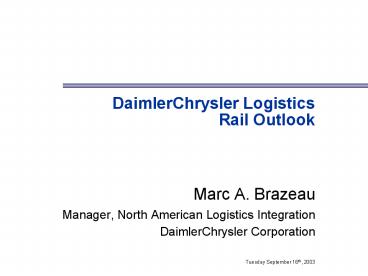DaimlerChrysler Logistics Rail Outlook - PowerPoint PPT Presentation
1 / 23
Title: DaimlerChrysler Logistics Rail Outlook
1
DaimlerChrysler Logistics Rail Outlook
- Marc A. Brazeau
- Manager, North American Logistics Integration
- DaimlerChrysler Corporation
- Tuesday September 16th, 2003
2
Chrysler Group Goals
C H R Y S L E R G R O U P
LEAN PROCESS STRATEGIES
- Quality
- Cost
- Technology
- Supply
- Procurement Supply
ShareholderValue
Customer Focus
LeanProcesses
AspirationalProducts
Motivated Employees
Disciplined Pizzazz
Suppliers adapt to delivery requirements defined
by World Wide Supply, NAFTA, GSC Strategy
2
3
DaimlerChrysler Supply Strategy
C H R Y S L E R G R O U P
- Common Understanding
- Vision - Shaping the worlds most effective
supply chain - Customer Focus
- Objectives
- Guiding Principles
- Supply backbone process sets framework for
interaction - Within DaimlerChrysler
- With Outside Customers
- Enablers
- IT
- Performance Measurement
- Human Resources
4
DaimlerChrysler Supply System
The Supply Backbone is the common process model
of DaimlerChrysler Supply.
5
Key Measures in the Automotive Logistics
- Quality
- Vehicle Damage Frequency
- Cost
- Material Cost Management
- Technology
- Insight Network Logistics
- Supply
- Vehicle Transit Time
Repair
Reward
Technology Quality
D
E
Resource
Repair
System Cost Supply
6
Logistics Industry
46 Decline
Overall Logistics and Transportation Expenditures
are down to a record low as a percentage of GDP
7
Cost
- MCM target is an 18.8 reduction in Logistics
cost through 2003 - Total Supply Cost Reduction of 31 per unit 2001
through 2006
8
Rail Industry
- The Transportation sector represents 8 of total
rail freight revenue - Rail and intermodal provide a cost effective
alternative to traditional transportation for the
automotive industry
- Intermodal volumes have increased 11.1 since
1999 5.8 last year alone. - Intermodal opportunity
- strengthening economy
- truckload capacity
- service improvements
5.8
9
DCX Parts Materials Transportation
2002 Logistics Expenditures of Spend
- 70,000 part shipments per day
- Daily, we unload
- 7700 truckloads
- 140 rail cars
30 from 2001
10
Network Optimization Chrysler Group
Collaboration of Strategic Partners
- Value-added partnerships provide strategic
solutions - Collaboration of multiple service providers
(Ryder, CSX, Union Pacific, TFM) provides lower
cost alternative unique to DCX. - Over 50 direct suppliers plus RILC material
launched on stack train. - 18 savings 14.2 million.
North and Southbound Stack Train
11
DCX Finished Vehicle Logistics
2002 Logistics Expenditures of Spend
- Ship 11,000 vehicles per day Over 2.5 million
vehicles in 2002. - 75 of all vehicles move via rail during their
route from manufacturing point to dealer
6 from 2001
12
Technology
Critical Factors for Vehicle Delivery Process
- Standardized Launch Planning
- Increased Carrier Base
- Extended Enterprise
- CAPS Modeling
- VIN Vision
- VIN Logic
- Route Optimization
- Asset Planning
- Performance Measurement
13
Supply
- Speed to Market Reliability, Visibility
- Process Control Continuous Improvement
- Visibility, Responsiveness Customer
Satisfaction
14
Capacity vs. Demand
- Industry volumes in North America are projected
to increase by 7 per year from 2003 to 2007 - Introduction of trucks, SUVs and crossover
vehicles will impact rail car supply - There is a widening gap between railcar
requirements and available supply
15
Asset Management
Railcar Capacity vs. Demand
- Improve transit time to reduce the gap between
equipment capacity and demand
- Make necessary capital equipment expenditures to
increase capacity of bi-levels and Q2 cars
16
Network Optimization Chrysler Group
- Ocean movement of finished vehicles from Mexico
to east coast ramps - Damage frequency reduced
- Transit time maintained
- Cost savings provided of 1.6 million per year
17
Quality - Damage Prevention
2002 Loss Damage Payments
by Commodity
Farm Products
Coal, Ore,
8.7
Misc. Mixed
Minerals
18.1
3.3
Food Products
11.6
Chemicals
5.6
Lumber, Wood
Paper Products
Transportation
10.0
Equipment
38.8
Metal Products
Machinery
3.9
- In 2002, Railroads paid 142.4 million for loss
and damage - 38.8 , or 55.2 million is attributed to
transportation equipment
18
US Auto Market Forecast
19
Effectively Track Funding
- Hurdle rate of 10 for rail capital programs
seems conservative - Automotive commodity draws on capital
- Line expansion
- Terminal capacity
- Asset Management
- Impact on captive shippers
- Subsidizing modal competitive commodities
- Reduced leverage
Source Eno Transportation Foundation
20
Investment Pyramid
- Suggests that investment is needed to satisfy
volume capacity - Must consider the range of commodity needs
- Public funding needs to be tied to
- Open access
- Co-production
- Commodity parity
Corridor capacity, intermodal terminals
Grade crossings, branch commuter lines
21
Automotive Freight Corridors
- Assessment of freight corridors
- Report example 2 Chicago gateway connections
- Report example 3 Northeast congestion
- Report example 5 Detroit Mexico corridor
- Automotive requirements
- Terminal yard capacity
- Regional line capacity
- Dimensional clearances
- Plan for growth
22
Possible Futures
- No Growth
- Widens the gap between captive and modal
competitive customers - Promotes internal commodity subsidies
- Would force the development of lower cost
alternatives - Constrained Investment
- Could address stop-gap capacity measures
- Focus would continue to be on supporting modal
competitive commodities - Wouldnt support asset renewal
- Base Case
- Would maintain current rate structure
- Most likely result in current service levels
- In light of shippers targets wouldnt
eliminate the on-going need to pursue service
alternatives - Aggressive Investment
- Promote effective capacity growth
- Support co-location/co-production projects
- Explore technological improvements
23
The Bottom Line
- Investment must satisfy railroads, shippers, and
public interest - Yard terminal capacity must be expanded to
satisfy volume increases - Projects must promote co-production and/or
cooperation - Any public funding must benefit all commodities
- Improve Customer Satisfaction
- Reduce Costs to Shippers
- Improve Profitability for Carriers
- Promote Opportunity for Growth of Rail
Transportation































